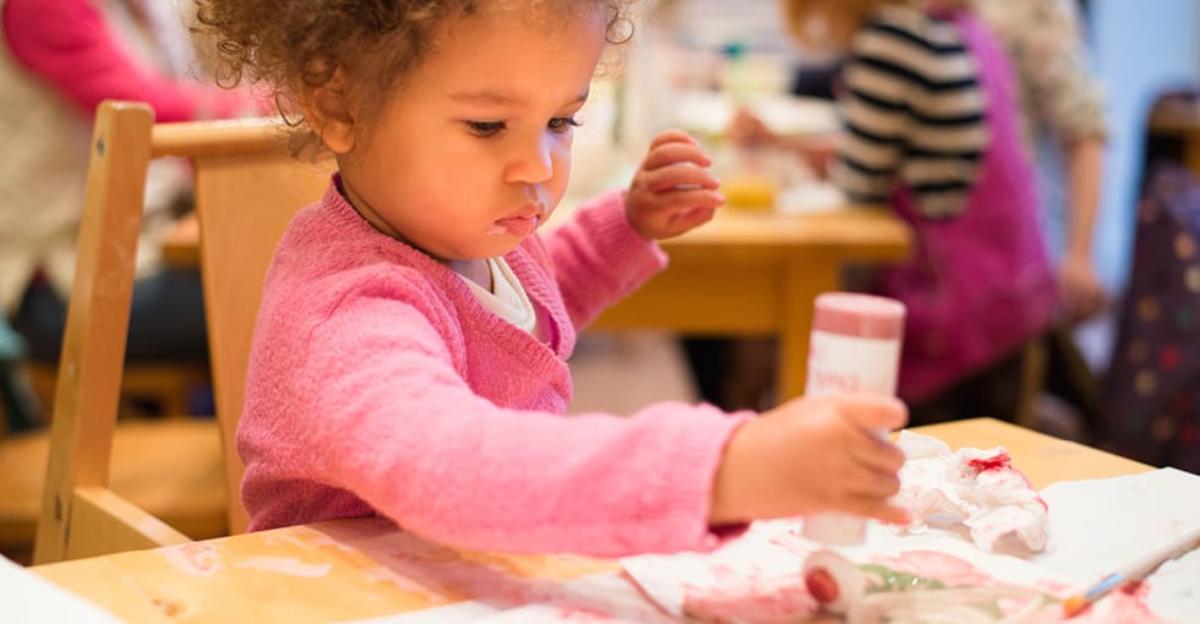If your preschoolers are painting with bath poufs and bubble wrap, the odds are good that you have a firm understanding of Process Art. And if you neglect to offer up a model project for your early learners to try and reproduce, that’s another point in your favor. Offering young children an opportunity to experience the gooey, sticky sensory feeling of finger paints and modeling clay or the inspiration that comes with safety scissors, colored glue and a box of rainbow-colored paper strips without any required end result, provides a young child the path to exploration, cognitive learning and creativity.
Process Art is, after all, about the process and not the finished product. It doesn’t have to resemble anything you’ve ever seen before. It doesn’t require that all the eyes be in all the right places or that all the colors be tucked neatly between the lines. It doesn’t have to be anything at all and certainly doesn’t need to be recognizable. In fact, the only requirement for this type of art project is that kids are having fun creating … something.
And if you have no idea what it is that’s looking back at you from the paper—or the wall or the sidewalk or the floor—that a preschooler just proudly pointed out, pat yourself on the back. You’re getting the hang of this type of art that thrives without boundaries on creativity.
Who Invented Process Art?
The term Process Art was coined by the artist Robert Morris in 1968, when he first began experimenting with soft felt to celebrate the way it was impacted by both gravity and stress. Sometimes called Anti-Form or Post-Minimalist art, Morris’ early works were achieved by a simple process of cut and drop — hence the unevenly arranged pile of pink felt scraps littering the floor at the Guggenheim Museum in New York.
The importance of Process Art is that it simply refuses to conform to anything. The finished product is actually unimportant. What matters is the process used to create it.
Process Art and the Preschool Curriculum
The National Association for the Education of Young Children (NAEYC) touts Process Art as highly developmentally appropriate for the preschool classroom, citing a number of benefits:
- Process Art nurtures social and emotional health, reinforcing such skills as relaxation, focus, self-esteem and emotional sharing.
- It helps to build such cognitive skills as comparison, prediction, planning and problem-solving.
- This form of art encourages the development of fine motor skills like painting, cutting and gluing.
- Process Art may also help to build the skills of verbal expression and language if the child chooses to discuss his or her work.
But your classroom full of early learners has no idea of what’s going on behind the scenes of this exceptionally fun and positive project. All they care about is that they were given free time to create something that has importance to them. They’ll get sticky. They’ll make messes. They’ll need more time than you were planning to give. But at the end of the day, you’ll have a classroom full of kids with excited stories to tell and artwork to show off.
Educators are using process art as part of their curriculum for the “A” in STEAM. And this trend is also in alignment with environmental rating scales such as ECERS, as it encourages open-ended activities that inspire sensory exploration and curiosity.
Your Role in “Process Art” Experience
If you plan to incorporate Process Art into your curriculum, there are strict rules for you, as instructor, to follow — as ironic as it sounds:
- Don’t be tempted to lead or guide kids into making something recognizable.
- Don’t give children a model project to try and copy.
- Don’t give in to the overwhelming urge to ask “What is it?”
- Be sure to provide a wealth of materials for preschoolers to work with — paint, crayons, paper, markers, safety scissors, clay, yarn, pencils and stamps.
- Never discourage a child from trying out his or her art idea unless it’s unsafe or impractical.
- Let the child decide what he or she wishes to do with the finished product.
And most importantly, make sure the time you dedicate to Process Art inside your preschool classroom is fun, relaxed and stress-free. Play music, move around and allow kids to come and go from their projects as needed. There are no fast and hard rules for your early learners when the subject is Process Art.
School Specialty has everything you need to make Process Art come alive for small kids with big imaginations. Visit our website today for a wealth of unique and affordable art supplies that speak directly to the process and not the finished product.






Leave a Reply